User:A22234798/沙盒100
| 安提坦戰役 夏普斯堡戰役 | |||||||
|---|---|---|---|---|---|---|---|
| 南北戰爭的一部分 | |||||||
 「安提坦戰役」,庫茲和艾莉森1878年繪製,描述了伯恩賽德橋軍事行動的場景 | |||||||
| |||||||
| 参战方 | |||||||
|
|
| ||||||
| 指挥官与领导者 | |||||||
| 喬治·B·麥克萊倫 | 羅伯特·李 | ||||||
| 参战单位 | |||||||
| 波多馬克軍團[2] |
北維吉尼亞軍團[3] 德克薩斯旅 | ||||||
| 兵力 | |||||||
| 87,164人[4][5] | 38,000人「參戰」[5] | ||||||
| 伤亡与损失 | |||||||
|
12,410人 2,108人戰死 9,549人負傷 753人被俘/失蹤[6][7] |
10,316人 1,567人戰死 7,752人負傷 1,018人被俘/失蹤[6][7] | ||||||
安提坦戰役(英語:Battle of Antietam,/ænˈtiːtəm/),也稱夏普斯堡戰役(英語:Battle of Sharpsburg),是南北戰爭中於美國南方的一場戰役,發生於1862年9月17日的夏普斯堡及安提坦溪附近,交戰雙方分別是羅伯特·李將軍率領的邦聯北維吉尼亞軍團,以及喬治·B·麥克萊倫將軍指揮的聯邦波多馬克軍團。這場戰役是馬里蘭會戰的一部分,也是南北戰爭東線戰場中第一場兩集團軍級別的交戰。安提坦戰役是美國軍事史上最血腥的一天,當天共有22,717人死亡、受傷或失蹤[8]。
喬治·B·麥克萊倫少將率領的聯邦軍在追擊羅伯特·李的邦聯軍進入馬里蘭州後,便向後者在安提坦溪後方的防禦陣地進攻。9月17日拂曉,約瑟夫·胡克少將麾下的兵團對邦聯軍左翼發起猛烈進攻。兩軍之間襲擊和反擊席捲了米勒的玉米田,並在鄧克教堂周圍混戰。聯邦軍對桑肯路的襲擊最終攻破了邦聯軍的中路,但聯邦軍的優勢並未擴大。下午時分,安布羅斯·伯恩賽德少將率領的聯邦兵團參戰,佔領了安提坦溪上的一座石橋,並向邦聯右翼推進。在這個關鍵時刻,A·P·希爾少將麾下的邦聯師從哈波斯渡口趕來並發動突襲反擊,隨後擊退了伯恩賽德並結束了戰鬥。雖然邦聯在人數上屈於一比二的劣勢,但李將軍投入了所有的部隊,而麥克萊倫只派出不到四分之三的軍隊參戰,這讓邦聯軍得以與聯邦軍在戰場上一較高下。當日夜裡,雙方都加固了各自的防線。儘管傷亡慘重,李將軍仍於9月18日派出部隊與麥克萊倫進行小規模作戰,並將他殘存的部隊撤往波多馬克河南側[9]。
儘管聯邦軍在人數上佔有優勢,但麥克萊倫的進攻還是無法達成部隊集結的目的,這讓李將軍能通過轉移部隊並沿著內線行軍來應對聯邦軍的挑戰。這就是為何麥克萊倫即便擁有足夠的預備隊(這些預備隊本可用來部署以擴大局部勝利的經驗),卻仍無法摧毀李將軍的邦聯軍。麥克萊倫堅持自己錯誤的認知,認定他在數量上寡不敵眾,這導致他在整場戰役中都過度謹慎。
麥克萊倫擋住了李將軍入侵馬里蘭的勢頭,但後者仍能不受過分謹慎的前者阻撓地將邦聯軍撤回維吉尼亞州。麥克萊倫拒絕追擊李將軍,從而導致他在11月被亞伯拉罕·林肯總統解職。雖然安提坦戰役最終在戰術上非決定性,但邦聯軍首先從戰場撤回並放棄入侵馬里蘭州,從而讓聯邦取得了戰略性勝利。這場足夠重大的勝利,讓林肯有信心發表解放奴隸宣言,該宣言透過解放邦聯各州共計超過350萬的奴隸,開始解放所有在法律上被視為美國奴隸的人。由於英法兩國在南北戰爭前就已事實上廢除奴隸制且時任政府強烈反對奴隸制,因此這個宣言阻礙了他們任何嘗試承認邦聯的潛在計畫。
背景:馬里蘭會戰
[编辑]
1862年8月30日,羅伯特·李在第二次馬納沙斯之役取勝,隨後其麾下的北維吉尼亞軍團約55,000人[10][11][12]於9月3日進入馬里蘭州。在成功的鼓舞下,邦聯高層打算將戰爭帶入敵方領土。李將軍對馬里蘭的入侵,是為了與同時入侵肯塔基州的布拉克斯頓·布拉格及埃德蒙·柯比·史密斯軍團相互呼應。後勤方面的原因也很重要,因為北維吉尼亞地區的農場已經缺乏食物了。基於1861年春天發生的巴爾的摩暴動,以及林肯總統在前往就職典禮的路上必須變相穿過巴爾的摩的事實,邦聯高層認為馬里蘭州會熱情地歡迎他們的到來。邦聯軍行軍時還唱著「馬里蘭,我的馬里蘭!」,但到了1862年秋天,馬里蘭州親聯邦的情緒壓倒了另一方的聲音,尤其該州西部更是如此。當李將軍的部隊經過州民的家門時,他們不是躲在房子裡,就是在一旁冷眼瞧著,與此相反,波多馬克軍團則是受到州民們得鼓舞與激勵。包括總統傑佛遜·戴維斯在內的部分邦聯政治人物都相信,如果他們能在聯邦領土上打一場勝仗,將會增加被外國承認的機會。這樣的勝利可能會得到英法兩國的認可及財政支持,雖然沒有證據顯示李將軍認為邦聯應該基於這種可能性制定相關的軍事計劃[13][14]。
當麥克萊倫麾下87,000人[4]的波多馬克軍團前去截擊李將軍時,兩位聯邦士兵[a]發現了三支雪茄,裡面裹著的正是李將軍遺失命令的副本,上面記載著邦聯詳細的戰鬥計畫。這個命令顯示出李將軍將分兵進擊哈波斯渡口及黑格斯敦,並在地理上分成了數個區塊,因此如果麥克萊倫進軍迅速,可將邦聯軍孤立的各部分別擊破。麥克萊倫等了大約18個小時後才決定利用這一情報並重新部署部隊,從而浪費了一次決定性地擊敗李將軍的機會[17]。
安提坦戰役前,雙方在馬里蘭會戰中進行了兩場重要的軍事行動:一是石牆傑克森少將攻佔哈波斯渡口,導致李將軍麾下大部因為參與聯邦軍的投降儀式,而缺席安提坦戰役初期階段;另一場則是麥克萊倫在南山之役中突襲穿越藍嶺山脈,但邦聯軍在兩隘道的堅守推遲了麥克萊倫的推進,從而使李將軍有足夠時間在夏普斯堡集結其餘部隊[18]。
交戰部隊
[编辑]| 參戰雙方總指揮官 |
|---|
聯邦軍
[编辑]| 聯邦各軍團指揮官 |
|---|
|
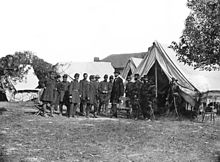
喬治·B·麥克萊倫少將麾下的波多馬克軍團,在吸收約翰·波普的維吉尼亞軍團後,增強到了六個步兵兵團[19][20]。
- 第一師,阿布納·道布爾迪准將
- 第一旅,沃爾特·菲爾普斯上校
- 第二旅,J·威廉·霍夫曼(J. William Hofmann)中校
- 第三旅,馬塞娜·魯道夫·帕特里克准將
- 第四旅,約翰·吉本准將
- 第二師,詹姆斯·B·里凱茨准將
- 第一旅,阿布拉姆·迪雷准將
- 第二旅,威廉·H·克里斯蒂安(William H. Christian)上校
- 第三旅,喬治·盧卡斯·哈楚夫准將
- 第三師,喬治·米德准將
- 第一旅,杜魯門·西摩准將
- 第二旅,阿爾伯特·馬吉爾頓(Albert Magilton)上校
- 第三旅,羅伯特·安德森(Robert Anderson)中校
- 第一師,伊斯瑞爾·B·理查德森少將
- 第一旅,約翰·C·考德威爾准將
- 第二旅,托馬斯·弗朗西斯·米格准將
- 第三旅,約翰·R·布魯克上校
- 第二師,約翰·塞奇威克少將
- 第一旅,威利斯·A·戈爾曼准將
- 第二旅,奧利弗·O·霍華德准將
- 第三旅,納波萊昂·J·T·達納准將
- 第三師,威廉·亨利·弗倫奇准將
- 第一師,喬治·W·莫雷爾少將
- 第二師,喬治·塞克斯准將
- 第三師,安德魯·A·亨弗瑞斯准將
- 第一旅,埃拉斯圖斯·B·泰勒准將
- 第二旅,彼得·H·阿拉巴赫上校
- 第一師,亨利·華納·斯洛克姆少將
- 第一旅,阿爾弗雷德·托馬斯·阿基米德斯·托伯特上校
- 第二旅,約瑟·J·巴特利特上校
- 第三旅,約翰·紐頓准將
- 第二師,威廉·F·「巴爾迪」·史密斯少將
- 第一旅,溫菲爾德·斯科特·漢考克准將
- 第二旅,威廉·T·H·布魯克斯准將
- 第三旅,威廉·H·歐文(William H. Irwin)上校
- 從第四兵團抽調的第一師,由達賴厄斯·納什·庫奇少將指揮
第九兵團,由安布羅斯·伯恩賽德少將(戰役期間由雅各布·道爾森·考克斯准將下達行動命令)指揮,下轄數個師:
- 第一師,奧蘭多·B·威爾考克斯准將
- 第一旅,本傑明·C·克里斯特上校
- 第二旅,湯瑪斯·威爾斯上校
- 第二師,塞繆爾·戴維斯·斯特吉斯准將
- 第三師,艾薩克·P·羅德曼准將
- 第一旅,哈里森·斯蒂爾斯·費爾柴爾德上校
- 第二旅,愛德華·詹姆斯·哈蘭上校
- 卡諾瓦師,埃里亞金·帕克·斯卡蒙上校
第十二兵團,由約瑟·K·曼斯菲爾德少將指揮,下轄數個師:
- 第一師,阿爾弗烏斯·S·威廉斯准將
- 第二師,喬治·S·格林准將
騎兵師,由阿爾弗雷德·普萊森頓准將指揮,下轄數個旅:
- 第一旅,查爾斯·J·惠廷少校
- 第二旅,約翰·F·法恩斯沃思上校
- 第三旅,理查德·H·拉什上校
- 第四旅,安德魯·麥克雷諾茲上校
- 第五旅,本傑明·富蘭克林·戴維斯上校
邦聯軍
[编辑]| 邦聯各軍團指揮官 |
|---|
李將軍將麾下的北維吉尼亞軍團組成兩大步兵兵團[11][21]。
- 拉法葉·麥克羅斯少將
- 約瑟夫·布里瓦德·科曉准將
- 豪厄爾·科布准將
- 保羅·西門斯准將
- 威廉·巴克斯戴爾准將
- 理查德·H·安德森少將
- 阿爾弗雷德·卡明二世(Alfred Cumming II)上校
- W·A·帕勒姆(W.A. Parham)上校
- 卡爾諾·波西上校
- 路易斯·亞米斯德准將
- 羅傑·阿特金森·普賴爾准將
- 安布洛斯·R·萊特准將
- 大衛·魯夫·瓊斯准將
- 約翰·喬治·沃克准將
- 約翰·貝爾·胡德准將
- 獨立旅,由內森·喬治·「香克斯」·埃文斯准將指揮
第二兵團,由石牆傑克森少將指揮,下轄各師:
- 亞歷山大·拉頓准將
- 馬爾切拉斯·杜格拉斯上校
- 具伯·爾利准將
- 詹姆斯·A·沃克上校
- 哈里·T·海斯准將
- 輕裝師,由安布羅斯·鮑威爾·希爾 少將指揮
- 勞倫斯·奧布萊恩·布賴奇准將
- 馬西·格雷格准將
- 詹姆斯·J·阿徹准將
- 威廉·多爾西·彭德准將
- 約翰·M·布羅肯布魯夫上校
- 艾華·洛依德·湯瑪斯上校
- 約翰·R·瓊斯准將
- 安德魯·J·格里斯比上校
- E·T·H·華倫上校
- 布拉德利·泰勒·約翰遜上校
- 威廉·E·史塔克准將
- 丹尼爾·哈維·希爾少將
- 羅斯威爾·S·李普利准將
- 羅伯特·E·羅迪斯准將
- 小薩繆爾·加蘭准將
- 喬治·B·安德森准將
- 阿爾弗雷德·H·考爾奇特上校
其餘部隊還包括詹姆斯·尤爾·布朗·史都華少將率領的騎兵團,以及威廉·N·彭德爾頓指揮的預備砲兵部隊。第二兵團的炮兵被配屬到各師當中,與第一兵團將砲兵留在兵團層級的配置不同。
戰役前奏
[编辑]軍隊部署
[编辑]
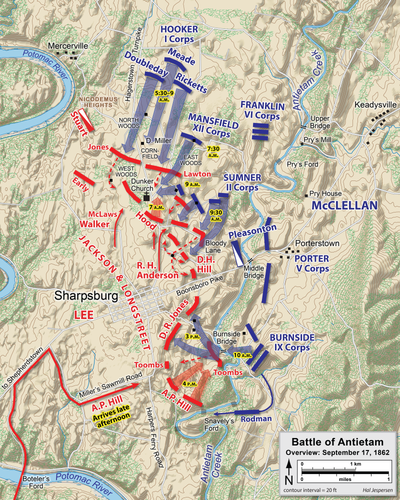
9月15日,李將軍開始將他可用的兵力沿著低脊(low ridge)部署於安提坦溪後方(夏普斯堡附近)。這雖然是有效的防禦陣地,但並非堅不可摧。當地地形為步兵提供了很好的掩護,上面有鐵柵欄和石圍牆、石灰岩露出部、小凹陷及低窪地。他們前面的小河只是一個小障礙,寬度從60英尺(18米)到100英尺(30米)不等,在某些地方是可橫渡的,並有三座兩兩相距1英里(1.6公里)的石橋橫越。但這對邦聯軍來說也是個危險的據點,因為他們的後方被波多馬克河所阻擋,如有需要時附近也僅有謝潑茲敦的波特勒淺灘(Boteler's Ford)可供撤離[b]。9月15日,李將軍可直接指揮的部隊不超過一萬八千人,這樣的兵力僅僅是聯邦軍的三分之一[22]。
9月15日下午,聯邦軍先頭兩個師抵達戰場,其餘大部則於當天傍晚到達。雖然聯邦軍如於9月16日早上立即攻擊將在數量上具有壓倒性的優勢,但麥克萊倫那謹慎的個性,以及相信李將軍在夏普斯堡的部隊高達十萬人,讓他將攻勢拖延至隔天[23]。這讓邦聯軍有更多時間能準備防禦陣地,並使隆史崔特的兵團及石牆傑克森的兵團[c]能分別從黑格斯敦及哈波斯渡口趕抵戰場。石牆傑克森依托波多馬克河駐防左翼(戰場北方),隆史崔特則依托安提坦溪駐防右翼(戰場南方),整條防線約4英里(6公里)長[d][24]。
9月16日傍晚,麥克萊倫下令胡克的第一兵團橫渡安提坦溪,並探查敵軍位置。米德部小心翼翼地襲擊了東樹林(East Woods)附近的胡德部。夜幕降臨後砲火依然持續,而麥克萊倫將他的部隊進行佈署以待隔日的戰鬥,他的計畫是壓倒敵軍左翼,而這個決定是根據安提坦溪上的橋樑配置所安排:下游的橋[e]由虛張聲勢的邦聯軍所控制,中游的橋[f]則處於夏普斯堡附近的火炮範圍下,而上游的橋距離最近的邦聯砲兵陣地約莫2英里(3.2公里),因此可從該處安全渡河。麥克萊倫計畫投入麾下一半以上的部隊,先以兩個兵團發起進攻,再由第三個兵團後續支援,如有必要甚至會投入第四個兵團。他打算以第五個兵團向邦聯右翼同時發起佯攻牽制,並於任何一邊的攻勢取得進展時,親率預備隊進攻中路[25]。雙方在東樹林的前哨戰讓李將軍得知了麥克萊倫的意圖,並依此對其防線做了相應的準備。李將軍將他的部隊轉移到左翼,並向還未抵達戰場的兩支部隊(拉法葉·麥克羅斯麾下的兩個師及A·P·希爾率領的一個師)發出緊急訊息[26][23]。
地形及其後果
[编辑]麥克萊倫的計畫相當不協調,而且執行地很糟糕。他對每個下屬指揮官只發出該軍團的指令,而不是整體戰鬥計畫的通盤命令。戰場的地形也讓這些指揮官很難監視其負責區域外的情形。而且麥克萊倫的總部設在戰場後方超過一英里處[g],這使得他很難控管與指揮各兵團。這就是為何隔天戰鬥的進行是三場獨立且不協調的戰鬥:早上在戰場北端,正午時分在中路,而下午在南端。麥克萊倫的部隊因此缺乏協同作戰及部隊集結的能力,這幾乎完全抵消其在數量上擁有的二比一優勢,也讓李將軍能調動其守軍來應對每次攻勢[23]。
戰役過程
[编辑]早上階段
[编辑]地點:戰場北端的玉米田

砲兵戰與肉搏戰
[编辑]9月17日拂曉約五點三十分,約瑟夫·胡克率領聯邦第一兵團對黑格斯敦公路(Hagerstown Turnpike)發起進攻,揭開了本場戰役的序幕。胡克的目標是坐落在高地上的鄧克教堂(Dunker Church),該教堂是端莊的白色粉刷建築物,屬於德國浸信會的支部。胡克麾下大約有8,600名士兵,略多於石牆傑克森率領的7,700名守軍,但聯邦軍這微弱的優勢被邦聯軍強大的防禦陣地徹底抵消[27] 。阿布納·道布爾迪的第一師移軍胡克部的右翼,詹姆斯·里凱茨的第二師則作為左翼進軍東樹林,而喬治·米德的第三師則部署於中路略為靠後的位置。石牆傑克森率領的邦聯守軍防線包含了亞歷山大·拉頓的師及約翰·R·瓊斯的師,他們的防線從西樹林(West Woods)開始,越過公路,並沿著米勒的玉米田南端。另外有四個旅則作為預備隊佈於西樹林中[28]。
當第一波聯邦軍從北樹林(North Woods)進入玉米田時,一場砲兵決鬥爆發了。邦聯砲火主要來自兩個方向,分別是傑布·史都華率領的馬砲台向西開火,以及高地上由斯蒂芬·D·李上校指揮的四座砲台從鄧克教堂向南開火。聯邦軍的回擊則由北樹林後方的九座砲台以及安提坦溪東方2英里(3公里)的20門20磅鸚鵡膛線炮進行。雙方交火導致的爆燃造成兩軍大量傷亡,李上校更將此描述為「砲火地獄(artillery Hell)」[29]。
由於看見了邦聯軍隱藏於玉米田中刺刀閃光,胡克便停下他麾下步兵的進軍,並帶上四座砲台,越過聯邦軍士兵的頭頂向玉米田砲轟。一場兇殘的戰鬥開始了,由於玉米田中可見度很低,雙方以步槍槍托及刺刀進行肉搏近戰。軍官們騎馬罵喊著命令,但沒有人可在戰場中聽到他們的聲音。步槍因為開槍多次過熱(hot)及損壞(fouled),空氣中則漫佈著子彈與砲彈[30]。
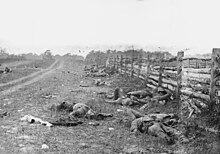
米德麾下由杜魯門·西摩准將率領的第一賓夕法尼亞旅,開始穿過東樹林推進,與詹姆斯·沃克指揮的邦聯旅[h]交火。由於沃克部在李上校的砲兵支援下擊退了西摩部,里凱茨的聯邦第二師開始進入玉米田,但同樣被邦聯砲兵轟個粉碎。阿布拉姆·迪雷准將的第一旅在行軍過程被馬爾切拉斯·杜格拉斯的邦聯喬治亞旅齊射,承受了250碼(230米)範圍內的巨量火力,在缺乏援軍且毫無進展的情形下,迪雷只能下令撤退[28]。
聯邦援軍的困境及戰局僵持
[编辑]迪雷期待的援軍,包括喬治·L·哈楚夫准將率領的第三旅及威廉·H·克里斯蒂安(William H. Christian)率領的第二旅,也都在支援的路上遭遇困難。哈楚夫因砲擊而負傷,而克里斯蒂安則在驚恐中下馬(dismounted)逃往後方。當這些聯邦軍終於集結起來向玉田推進時,他們也如先前部隊一樣,遭到同樣砲兵即部兵火力的攻擊。由於聯邦軍的優勢兵力開始產生影響(began to tell),哈里·海斯率領邦聯的路易斯安那「猛虎(Tiger)」旅加入戰鬥(entered the fray),並將聯邦軍逐回東樹林。第12麻塞諸塞步兵團所承受的傷亡率高達67%,當日所有參戰單位中最高的[31]。最終,當聯邦軍拿出一門3英寸的軍械來福砲,並將其直接滾入玉米田時,猛烈屠殺了猛虎旅500名士兵中的323人,導致後者最終還是被擊退了[32]。
(...the most deadly fire of the war. Rifles are shot to pieces in the hands of the soldiers, canteens and haversacks are riddled with bullets, the dead and wounded go down in scores.)
於他們被路易斯安那猛虎旅在玉米田攻擊時所述[33]。
當玉米田仍處於血腥的僵局時,聯邦軍向西推進了數百碼取得了較大的成功。約翰·吉本准將率領第一師第四旅(最近剛被命名為鋼鐵旅)開始往下推進,越過公路進入麥田,並在西部森林逐退石牆傑克森的部隊[34]。他們的推進被邦聯史塔克旅之1,150人的衝鋒所阻止,並被30碼(30米)外的重火力夷為平地。邦聯旅在遭受鋼鐵旅進行兇猛反擊後撤離戰場,史塔克本人也身負重傷[35]。聯邦軍得以向鄧克教堂推進,並將石牆傑克森的防線切出一大缺口,幾乎導致邦聯戰線的崩潰。雖然代價高昂,胡克兵團最終還是取得穩定的進度。
邦聯援軍抵達
[编辑]邦聯援軍於早上七點不久後抵達:McLaws及Richard H. Anderson率領部隊自哈波斯渡口夜行軍而來。七點十五分左右,李將軍將George T. Anderson的喬治亞旅派往右翼以支援石牆傑克森。胡德師的兩千三百人在早上七點向西樹林推進,再次將聯邦軍逐回玉米田。The Texans attacked with particular ferocity because as they were called from their reserve position they were forced to interrupt the first hot breakfast they had had in days. They were aided by three brigades of D.H. Hill's division arriving from the Mumma Farm, southeast of the Cornfield, and by Jubal Early's brigade, pushing through the West Woods from the Nicodemus Farm, where they had been supporting Jeb Stuart's horse artillery. Some officers of the Iron Brigade rallied men around the artillery pieces of Battery B, 4th U.S. Artillery, and Gibbon himself saw to it that his previous unit did not lose a single caisson.[36] Hood's men bore the brunt of the fighting, however, and paid a heavy price—60% casualties—but they were able to prevent the defensive line from crumbling and held off the I Corps. When asked by a fellow officer where his division was, Hood replied, "Dead on the field."[37]
Hooker's men had also paid heavily but without achieving their objectives. After two hours and 2,500 casualties, they were back where they started. The Cornfield, an area about 250碼(230米) deep and 400碼(400米) wide, was a scene of indescribable destruction. It was estimated that the Cornfield changed hands no fewer than 15 times in the course of the morning.[38] Major Rufus R. Dawes, who assumed command of Iron Brigade's 6th Wisconsin Regiment during the battle, later compared the fighting around the Hagerstown Turnpike with the stone wall at Fredericksburg, Spotsylvania's "Bloody Angle", and the slaughter pen of Cold Harbor, insisting that "the Antietam Turnpike surpassed them all in manifest evidence of slaughter."[39] Hooker called for support from the 7,200 men of Mansfield's XII Corps.
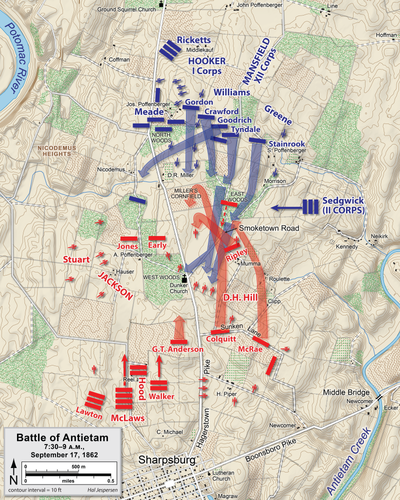
Half of Mansfield's men were raw recruits, and Mansfield was also inexperienced, having taken command only two days before. Although he was a veteran of 40 years' service, he had never led large numbers of soldiers in combat. Concerned that his men would bolt under fire, he marched them in a formation that was known as "column of companies, closed in mass," a bunched-up formation in which a regiment was arrayed ten ranks deep instead of the normal two. As his men entered the East Woods, they presented an excellent artillery target, "almost as good a target as a barn." Mansfield himself was shot in the chest and died the next day. Alpheus Williams assumed temporary command of the XII Corps.[40][41]
The new recruits of Mansfield's 1st Division made no progress against Hood's line, which was reinforced by brigades of D.H. Hill's division under Colquitt and McRae. The 2nd Division of the XII Corps, under George Sears Greene, however, broke through McRae's men, who fled under the mistaken belief that they were about to be trapped by a flanking attack. This breach of the line forced Hood and his men, outnumbered, to regroup in the West Woods, where they had started the day.[31] Greene was able to reach the Dunker Church, Hooker's original objective, and drove off Stephen Lee's batteries. Federal forces held most of the ground to the east of the turnpike.
Hooker attempted to gather the scattered remnants of his I Corps to continue the assault, but a Confederate sharpshooter spotted the general's conspicuous white horse and shot Hooker through the foot. Command of his I Corps fell to General Meade, since Hooker's senior subordinate, James B. Ricketts, had also been wounded. But with Hooker removed from the field, there was no general left with the authority to rally the men of the I and XII Corps. Greene's men came under heavy fire from the West Woods and withdrew from the Dunker Church.
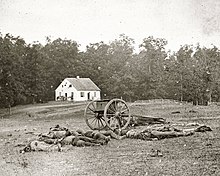
In an effort to turn the Confederate left flank and relieve the pressure on Mansfield's men, Sumner's II Corps was ordered at 7:20 a.m. to send two divisions into battle. Sedgwick's division of 5,400 men was the first to ford the Antietam, and they entered the East Woods with the intention of turning left and forcing the Confederates south into the assault of Ambrose Burnside's IX Corps. But the plan went awry. They became separated from William H. French's division, and at 9 a.m. Sumner, who was accompanying the division, launched the attack with an unusual battle formation—the three brigades in three long lines, men side-by-side, with only 50 to 70碼(60米) separating the lines. They were assaulted first by Confederate artillery and then from three sides by the divisions of Early, Walker, and McLaws, and in less than half an hour Sedgwick's men were forced to retreat in great disorder to their starting point with over 2,200 casualties, including Sedgwick himself, who was taken out of action for several months by a wound.[42][43][44][45] Sumner has been condemned by most historians for his "reckless" attack, his lack of coordination with the I and XII Corps headquarters, losing control of French's division when he accompanied Sedgwick's, failing to perform adequate reconnaissance prior to launching his attack, and selecting the unusual battle formation that was so effectively flanked by the Confederate counterattack. Historian M. V. Armstrong's recent scholarship, however, has determined that Sumner did perform appropriate reconnaissance and his decision to attack where he did was justified by the information available to him.[46]
The final actions in the morning phase of the battle were around 10 a.m., when two regiments of the XII Corps advanced, only to be confronted by the division of John G. Walker, newly arrived from the Confederate right. They fought in the area between the Cornfield in the West Woods, but soon Walker's men were forced back by two brigades of Greene's division, and the Federal troops seized some ground in the West Woods.
The morning phase ended with casualties on both sides of almost 13,000, including two Union corps commanders.[47]
正午階段
[编辑]地點:邦聯中路戰線
桑肯路:「血腥之道」(Sunken Road: "Bloody Lane")
[编辑]
By midday, the action had shifted to the center of the Confederate line. Sumner had accompanied the morning attack of Sedgwick's division, but another of his divisions, under French, lost contact with Sumner and Sedgwick and inexplicably headed south. Eager for an opportunity to see combat, French found skirmishers in his path and ordered his men forward. By this time, Sumner's aide (and son) located French, described the terrible fighting in the West Woods and relayed an order for him to divert Confederate attention by attacking their center.[48]
French confronted D.H. Hill's division. Hill commanded about 2,500 men, less than half the number under French, and three of his five brigades had been torn up during the morning combat. This sector of Longstreet's line was theoretically the weakest. But Hill's men were in a strong defensive position, atop a gradual ridge, in a sunken road worn down by years of wagon traffic, which formed a natural trench.[49]
French launched a series of brigade-sized assaults against Hill's improvised breastworks at around 9:30 a.m.. The first brigade to attack, mostly inexperienced troops commanded by Brig. Gen. Max Weber, was quickly cut down by heavy rifle fire; neither side deployed artillery at this point. The second attack, more raw recruits under Col. Dwight Morris, was also subjected to heavy fire but managed to beat back a counterattack by the Alabama Brigade of Robert Rodes. The third, under Brig. Gen. Nathan Kimball, included three veteran regiments, but they also fell to fire from the sunken road. French's division suffered 1,750 casualties (of his 5,700 men) in under an hour.[50]
Reinforcements were arriving on both sides, and by 10:30 a.m. Robert E. Lee sent his final reserve division—some 3,400 men under Maj. Gen. Richard H. Anderson—to bolster Hill's line and extend it to the right, preparing an attack that would envelop French's left flank. But at the same time, the 4,000 men of Maj. Gen. Israel B. Richardson's division arrived on French's left. This was the last of Sumner's three divisions, which had been held up in the rear by McClellan as he organized his reserve forces.[51] Richardson's fresh troops struck the first blow.

Leading off the fourth attack of the day against the sunken road was the Irish Brigade of Brig. Gen. Thomas F. Meagher. As they advanced with emerald green flags snapping in the breeze, a regimental chaplain, Father William Corby, rode back and forth across the front of the formation shouting words of conditional absolution prescribed by the Roman Catholic Church for those who were about to die. (Corby would later perform a similar service at Gettysburg in 1863.) The mostly Irish immigrants lost 540 men to heavy volleys before they were ordered to withdraw.[52]
Gen. Richardson personally dispatched the brigade of Brig. Gen. John C. Caldwell into battle around noon (after being told that Caldwell was in the rear, behind a haystack), and finally the tide turned. Anderson's Confederate division had been little help to the defenders after Gen. Anderson was wounded early in the fighting. Other key leaders were lost as well, including George B. Anderson (no relation; Anderson's successor, Col. Charles C. Tew of the 2nd North Carolina, was killed minutes after assuming command)[53] and Col. John B. Gordon of the 6th Alabama. (Gordon received 5 serious wounds in the fight, twice in his right leg, twice in the left arm, and once in the face. He lay unconscious, face down in his cap, and later told colleagues that he should have smothered in his own blood, except for the act of an unidentified Yankee, who had earlier shot a hole in his cap, which allowed the blood to drain.)[54] Rodes was wounded in the thigh but was still on the field. These losses contributed directly to the confusion of the following events.
As Caldwell's brigade advanced around the right flank of the Confederates, Col. Francis C. Barlow and 350 men of the 61st and 64th New York saw a weak point in the line and seized a knoll commanding the sunken road. This allowed them to get enfilade fire into the Confederate line, turning it into a deadly trap. In attempting to wheel around to meet this threat, a command from Rodes was misunderstood by Lt. Col. James N. Lightfoot, who had succeeded the unconscious John Gordon. Lightfoot ordered his men to about-face and march away, an order that all five regiments of the brigade thought applied to them as well. Confederate troops streamed toward Sharpsburg, their line lost.
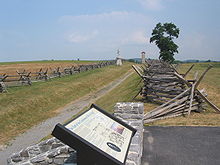
Richardson's men were in hot pursuit when massed artillery hastily assembled by Gen. Longstreet drove them back. A counterattack with 200 men led by D.H. Hill got around the Federal left flank near the sunken road, and although they were driven back by a fierce charge of the 5th New Hampshire, this stemmed the collapse of the center. Reluctantly, Richardson ordered his division to fall back to north of the ridge facing the sunken road. His division lost about 1,000 men. Col. Barlow was severely wounded, and Richardson mortally wounded.[56] Winfield S. Hancock assumed division command. Although Hancock would have an excellent future reputation as an aggressive division and corps commander, the unexpected change of command sapped the momentum of the Federal advance.[57]

The carnage from 9:30 a.m. to 1:00 p.m. on the sunken road gave it the name Bloody Lane, leaving about 5,600 casualties (Union 3,000, Confederate 2,600) along the 800-碼(700-米) road. And yet a great opportunity presented itself. If this broken sector of the Confederate line were exploited, Lee's army would have been divided in half and possibly defeated. There were ample forces available to do so. There was a reserve of 3,500 cavalry and the 10,300 infantrymen of Gen. Porter's V Corps, waiting near the middle bridge, a mile away. The VI Corps, under Maj. Gen. William B. Franklin, had just arrived with 12,000 men. Franklin was ready to exploit this breakthrough, but Sumner, the senior corps commander, ordered him not to advance. Franklin appealed to McClellan, who left his headquarters in the rear to hear both arguments but backed Sumner's decision, ordering Franklin and Hancock to hold their positions.[58]
Later in the day, the commander of the other reserve unit near the center, the V Corps, Maj. Gen. Fitz John Porter, heard recommendations from Maj. Gen. George Sykes, commanding his 2nd Division, that another attack be made in the center, an idea that intrigued McClellan. However, Porter is said to have told McClellan, "Remember, General, I command the last reserve of the last Army of the Republic." McClellan demurred and another opportunity was lost.[59]
下午階段
[编辑]地點:戰場南端
「伯恩賽德橋」
[编辑]
The action moved to the southern end of the battlefield. McClellan's plan called for Maj. Gen. Ambrose Burnside and the IX Corps to conduct a diversionary attack in support of Hooker's I Corps, hoping to draw Confederate attention away from the intended main attack in the north. However, Burnside was instructed to wait for explicit orders before launching his attack, and those orders did not reach him until 10 a.m.[60] Burnside was strangely passive during preparations for the battle. He was disgruntled that McClellan had abandoned the previous arrangement of "wing" commanders reporting to him. Previously, Burnside had commanded a wing that included both the I and IX Corps and now he was responsible only for the IX Corps. Implicitly refusing to give up his higher authority, Burnside treated first Maj. Gen. Jesse L. Reno (killed at South Mountain) and then Brig. Gen. Jacob D. Cox of the Kanawha Division as the corps commander, funneling orders to the corps through him.
Burnside had four divisions (12,500 troops) and 50 guns east of Antietam Creek. Facing him was a force that had been greatly depleted by Lee's movement of units to bolster the Confederate left flank. At dawn, the divisions of Brig. Gens. David R. Jones and John G. Walker stood in defense, but by 10 a.m. all of Walker's men and Col. George T. Anderson's Georgia brigade had been removed. Jones had only about 3,000 men and 12 guns available to meet Burnside. Four thin brigades guarded the ridges near Sharpsburg, primarily a low plateau known as Cemetery Hill. The remaining 400 men—the 2nd and 20th Georgia regiments, under the command of Brig. Gen. Robert Toombs, with two artillery batteries—defended Rohrbach's Bridge, a three-span, 125-foot (38 m) stone structure that was the southernmost crossing of the Antietam.[61] It would become known to history as Burnside's Bridge because of the notoriety of the coming battle. The bridge was a difficult objective. The road leading to it ran parallel to the creek and was exposed to enemy fire. The bridge was dominated by a 100-foot (30 m) high wooded bluff on the west bank, strewn with boulders from an old quarry, making infantry and sharpshooter fire from good covered positions a dangerous impediment to crossing.
Antietam Creek in this sector was seldom more than 50 feet (15 m) wide, and several stretches were only waist deep and out of Confederate range. Burnside has been widely criticized for ignoring this fact.[62] However, the commanding terrain across the sometimes shallow creek made crossing the water a comparatively easy part of a difficult problem. Burnside concentrated his plan instead on storming the bridge while simultaneously crossing a ford McClellan's engineers had identified a half mile (1 km) downstream, but when Burnside's men reached it, they found the banks too high to negotiate. While Col. George Crook's Ohio brigade prepared to attack the bridge with the support of Brig. Gen. Samuel Sturgis's division, the rest of the Kanawha Division and Brig. Gen. Isaac Rodman's division struggled through thick brush trying to locate Snavely's Ford, 2 miles (3 km) downstream, intending to flank the Confederates.[63][61][64]
Crook's assault on the bridge was led by skirmishers from the 11th Connecticut, who were ordered to clear the bridge for the Ohioans to cross and assault the bluff. After receiving punishing fire for 15 minutes, the Connecticut men withdrew with 139 casualties, one-third of their strength, including their commander, Col. Henry W. Kingsbury, who was fatally wounded.[65] Crook's main assault went awry when his unfamiliarity with the terrain caused his men to reach the creek a quarter mile (400 m) upstream from the bridge, where they exchanged volleys with Confederate skirmishers for the next few hours.[66]
While Rodman's division was out of touch, slogging toward Snavely's Ford, Burnside and Cox directed a second assault at the bridge by one of Sturgis's brigades, led by the 2nd Maryland and 6th New Hampshire. They also fell prey to the Confederate sharpshooters and artillery, and their attack fell apart.[67] By this time it was noon, and McClellan was losing patience. He sent a succession of couriers to motivate Burnside to move forward. He ordered one aide, "Tell him if it costs 10,000 men he must go now." He increased the pressure by sending his inspector general, Col. Delos B. Sackett, to confront Burnside, who reacted indignantly: "McClellan appears to think I am not trying my best to carry this bridge; you are the third or fourth one who has been to me this morning with similar orders."[68]
The third attempt to take the bridge was at 12:30 p.m. by Sturgis's other brigade, commanded by Brig. Gen. Edward Ferrero. It was led by the 51st New York and the 51st Pennsylvania, who, with adequate artillery support and a promise that a recently canceled whiskey ration would be restored if they were successful, charged downhill and took up positions on the east bank. Maneuvering a captured light howitzer into position, they fired double canister down the bridge and got within 25碼(23米) of the enemy. By 1 p.m., Confederate ammunition was running low, and word reached Toombs that Rodman's men were crossing Snavely's Ford on their flank. He ordered a withdrawal. His Georgians had cost the Federals more than 500 casualties, giving up fewer than 160 themselves. And they had stalled Burnside's assault on the southern flank for more than three hours.[69][70]
-
Charge of the 51st New York and 51st Pennsylvania across Burnside's Bridge, by Edwin Forbes -
Battle of Antietam by Kurz and Allison -
Confederate guns on the hill above poured fire into the Union ranks at Burnside's bridge. Photo taken just after the Battle of Antietam, 1862. -
Union positions below the Confederates at Burnside Bridge
-
Burnside Bridge in 2012
Burnside's assault stalled again on its own. His officers had neglected to transport ammunition across the bridge, which was itself becoming a bottleneck for soldiers, artillery, and wagons. This represented another two-hour delay. Gen. Lee used this time to bolster his right flank. He ordered up every available artillery unit, although he made no attempt to strengthen D.R. Jones's badly outnumbered force with infantry units from the left. Instead, he counted on the arrival of A.P. Hill's Light Division, currently embarked on an exhausting 17 mile (27 km) march from Harpers Ferry. By 2 p.m., Hill's men had reached Boteler's Ford, and Hill was able to confer with the relieved Lee at 2:30, who ordered him to bring up his men to the right of Jones.[71]
The Federals were completely unaware that 3,000 new men would be facing them. Burnside's plan was to move around the weakened Confederate right flank, converge on Sharpsburg, and cut Lee's army off from Boteler's Ford, their only escape route across the Potomac. At 3 p.m., Burnside left Sturgis's division in reserve on the west bank and moved west with over 8,000 troops (most of them fresh) and 22 guns for close support.[72]
An initial assault led by the 79th New York "Cameron Highlanders" succeeded against Jones's outnumbered division, which was pushed back past Cemetery Hill and to within 200碼(200米) of Sharpsburg. Farther to the left, Rodman's division advanced toward Harpers Ferry Road. Its lead brigade, under Col. Harrison Fairchild, containing several colorful Zouaves of the 9th New York, commanded by Col. Rush Hawkins, came under heavy shellfire from a dozen enemy guns mounted on a ridge to their front, but they kept pushing forward. There was panic in the streets of Sharpsburg, clogged with retreating Confederates. Of the five brigades in Jones's division, only Toombs's brigade was still intact, but he had only 700 men.[73]
A. P. Hill's division arrived at 3:30 p.m. Hill divided his column, with two brigades moving southeast to guard his flank and the other three, about 2,000 men, moving to the right of Toombs's brigade and preparing for a counterattack. At 3:40 p.m., Brig. Gen. Maxcy Gregg's brigade of South Carolinians attacked the 16th Connecticut on Rodman's left flank in the cornfield of farmer John Otto. The Connecticut men had been in service for only three weeks, and their line disintegrated with 185 casualties. The 4th Rhode Island came up on the right, but they had poor visibility amid the high stalks of corn, and they were disoriented because many of the Confederates were wearing Union uniforms captured at Harpers Ferry. They also broke and ran, leaving the 8th Connecticut far out in advance and isolated. They were enveloped and driven down the hills toward Antietam Creek. A counterattack by regiments from the Kanawha Division fell short.[74]
The IX Corps had suffered casualties of about 20% but still possessed twice the number of Confederates confronting them. Unnerved by the collapse of his flank, Burnside ordered his men all the way back to the west bank of the Antietam, where he urgently requested more men and guns. McClellan was able to provide just one battery. He said, "I can do nothing more. I have no infantry." In fact, however, McClellan had two fresh corps in reserve, Porter's V and Franklin's VI, but he was too cautious, concerned he was greatly outnumbered and that a massive counterstrike by Lee was imminent. Burnside's men spent the rest of the day guarding the bridge they had suffered so much to capture.[75]
後續發展
[编辑]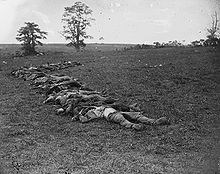
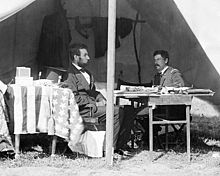
The battle was over by 5:30 p.m. On the morning of September 18, Lee's army prepared to defend against a Federal assault that never came. After an improvised truce for both sides to recover and exchange their wounded, Lee's forces began withdrawing across the Potomac that evening to return to Virginia.[77] Losses from the battle were heavy on both sides. The Union had 12,410 casualties with 2,108 dead.[6] Confederate casualties were 10,316 with 1,546 dead.[7][78] This represented 25% of the Federal force and 31% of the Confederates. Overall, both sides lost a combined total of 22,720 casualties in a single day, almost the same amount as the number of losses that had shocked the nation at the 2-day Battle of Shiloh five months earlier.[79] Of the other casualties, 1,910 Union and 1,550 Confederate troops died of their wounds soon after the battle, while 225 Union and 306 Confederate troops listed as missing were later confirmed as dead. Several generals died as a result of the battle, including Maj. Gens. Joseph K. Mansfield and Israel B. Richardson and Brig. Gen. Isaac P. Rodman on the Union side, and Brig. Gens. Lawrence O. Branch and William E. Starke on the Confederate side.[80] Confederate Brig. Gen. George B. Anderson was shot in the ankle during the defense of the Bloody Lane. He survived the battle but died later in October after an amputation.[54] The fighting on September 17, 1862, killed 7,650 American soldiers.[81] More Americans died in battle on September 17, 1862, than on any other day in the nation's history. Antietam is sometimes cited as the bloodiest day in all of American history, but the deaths from the Galveston Hurricane of 1900 are significantly higher.[來源請求] The bloodiest battle in American history was Gettysburg, but its more than 46,000 casualties occurred over three days. Antietam ranks fifth in terms of total casualties in Civil War battles, falling behind Gettysburg, Chickamauga, Chancellorsville, and Spotsylvania Court House.
President Lincoln was disappointed in McClellan's performance. He believed that McClellan's overly cautious and poorly coordinated actions in the field had forced the battle to a draw rather than a crippling Confederate defeat.[82] The president was even more astonished that from September 17 to October 26, despite repeated entreaties from the War Department and the president himself, McClellan declined to pursue Lee across the Potomac, citing shortages of equipment and the fear of overextending his forces. General-in-Chief Henry W. Halleck wrote in his official report, "The long inactivity of so large an army in the face of a defeated foe, and during the most favorable season for rapid movements and a vigorous campaign, was a matter of great disappointment and regret."[83] Lincoln relieved McClellan of his command of the Army of the Potomac on November 5, effectively ending the general's military career. He was replaced on November 9 by General Burnside.[84]
| 外部视频链接 | |
|---|---|
Some students of history question the designation of "strategic victory" for the Union. After all, it can be argued that McClellan performed poorly in the campaign and the battle itself, and Lee displayed great generalship in holding his own in battle against an army that greatly outnumbered his. Casualties were comparable on both sides, although Lee lost a higher percentage of his army. Lee withdrew from the battlefield first, the technical definition of the tactical loser in a Civil War battle. However, in a strategic sense, despite being a tactical draw, Antietam is considered a turning point of the war and a victory for the Union because it ended Lee's strategic campaign (his first invasion of Union territory). American historian James M. McPherson summed up the importance of the Battle of Antietam in his book, Crossroads of Freedom:
No other campaign and battle in the war had such momentous, multiple consequences as Antietam. In July 1863 the dual Union triumphs at Gettysburg and Vicksburg struck another blow that blunted a renewed Confederate offensive in the East and cut off the western third of the Confederacy from the rest. In September 1864 Sherman's capture of Atlanta electrified the North and set the stage for the final drive to Union victory. These also were pivotal moments. But they would never have happened if the triple Confederate offensives in Mississippi, Kentucky, and most of all Maryland had not been defeated in the fall of 1862.[85]
The results of Antietam also allowed President Lincoln to issue the preliminary Emancipation Proclamation on September 22, which gave Confederate states until January 1, 1863, to return or else lose their slaves. Although Lincoln had intended to do so earlier, he was advised by his Cabinet to make this announcement after a Union victory to avoid the perception that it was issued out of desperation.
The Union victory and Lincoln's proclamation played a considerable role in dissuading the governments of France and Britain from recognizing the Confederacy; some suspected they were planning to do so in the aftermath of another Union defeat. When the issue of emancipation was linked to the progress of the war, neither government had the political will to oppose the United States, since it linked support of the Confederacy to support for slavery. Both countries had already abolished slavery, and the public would not have tolerated the government militarily supporting a sovereignty upholding the ideals of slavery.[86]
戰場保存
[编辑]The battle is commemorated at Antietam National Battlefield. Conservation work undertaken by Antietam National Battlefield and private groups, has earned Antietam a reputation as one of the nation's best preserved Civil War battlefields. Few visual intrusions mar the landscape, letting visitors experience the site nearly as it was in 1862.[87]
Antietam was one of the first five Civil War battlefields preserved federally, receiving that distinction on August 30, 1890. The U.S. War Department also placed over 300 tablets at that time to mark the spots of individual regiments and of significant phases in the battle. The battlefield was transferred to the Department of the Interior in 1933. The Antietam National Battlefield now consists of 2,743 acres.
The Civil War Trust (a division of the American Battlefield Trust) and its partners have acquired and preserved 316 acres of the Antietam Battlefield.[88] In 2015, the Trust saved 44.4 acres in the heart of the battlefield, between the Cornfield and the Dunker Church, when it purchased the Wilson farm for about $1 million.[89] The preservation organization has since removed the postwar house and barn that stood on the property along Hagerstown Pike and returned the land to its wartime appearance.[90]
歷史照片和繪畫
[编辑]Mathew Brady's gallery, "The Dead of Antietam" (1862)
[编辑]On September 19, 1862, two days after the Battle of Antietam, Mathew Brady sent photographer Alexander Gardner and his assistant James Gibson[91] to photograph the carnage. In October 1862 Brady displayed the photos by Gardner in an exhibition entitled "The Dead of Antietam" at Brady's New York gallery. Many images in this presentation were graphic photographs of corpses, a presentation new to America. This was the first time that many Americans saw the realities of war in photographs as distinct from previous "artists' impressions".[92] The New York Times published a review on October 20, 1862, describing how, "Of all objects of horror one would think the battle-field should stand preeminent, that it should bear away the palm of repulsiveness." But crowds came to the gallery drawn by a "terrible fascination" to the images of mangled corpses which brought the reality of remote battle fields to New Yorkers. Viewers examined details using a magnifying glass. "We would scarce choose to be in the gallery, when one of the women bending over them should recognize a husband, a son, or a brother in the still, lifeless lines of bodies, that lie ready for the gaping trenches."[93]
Captain James Hope murals
[编辑]Captain James Hope of the 2nd Vermont Infantry, a professional artist, painted five large murals based on battlefield scenes he had sketched during the Battle of Antietam. He had been assigned to sideline duties as a scout and mapmaker due to his injuries. The canvasses were exhibited in his gallery in Watkins Glen, New York, until his death in 1892. He had prints made of these larger paintings and sold the reproductions. In the 1930s his work was damaged in a flood. The original murals were shown in a church for many years. In 1979, the National Park Service purchased and restored them.[94][95] They were featured in a 1984 Time-Life book entitled The Bloodiest Day: The Battle of Antietam.[96]
圖集
[编辑]The images below include photographs by Alexander Gardner, who was employed by Mathew Brady and whose photographs were exhibited in Brady's New York gallery in October 1862, and the murals by Captain James Hope restored by the National Park Service.
-
Confederate soldiers on the Antietam battlefield as they fell inside the fence on the Hagerstown road, September 1862 by Alexander Gardner -
Harper's Weekly drawing of dead soldiers on Antietam battlefield, based on Gardner photograph -
Confederate horses lay dead and artillery caissons destroyed on Antietam battlefield[97] -
Dead on Antietam battlefield[98] -
Confederate dead at Bloody Lane, looking east from the north bank. Alexander Gardner photograph. -
Confederate dead at Bloody Lane, looking northeast from the south bank. Alexander Gardner photograph.[99] -
"Confederate soldier who after being wounded had evidently dragged himself to a little ravine on the hillside where he died".[76] Photograph by Alexander Gardner. -
Federal burial party by Alexander Gardner[100] -
Burying Union dead on the Antietam battlefield -
"A Lonely Grave" — Federal grave at Antietam by Alexander Gardner[101] -
Antietam Battlefield photograph by Alexander Gardner[102] -
Artillery hell by Captain James Hope (Dunker Church at the far left) -
"A Fateful Turn" — Late morning looking east toward the Roulette Farm by Captain James Hope -
"The Aftermath at Bloody Lane" by Captain James Hope -
"Wasted Gallantry" by Captain James Hope -
Burnside Bridge by Captain James Hope -
The Lutheran Church just east of Sharpsburg marks the extent of the Union offensive during the Battle of Antietam, 1862.
公眾文化
[编辑]The Battle of Antietam was featured at the beginning of the film Glory (1989), directed by Edward Zwick and starring Matthew Broderick, Denzel Washington, Cary Elwes, and Morgan Freeman. The scene depicts the wounding of Captain Robert Gould Shaw of Massachusetts.[103][104]
The Massachusetts-based ink manufacturer Noodler's[105] carries an ink called Antietam. The colour is a reddish brown.
參見
[编辑]註解
[编辑]參考
[编辑]- ^ NPS; see the discussion of "strategic victory" in the Aftermath section.
- ^ 更多資訊: Official Records, Series I, Volume XIX, Part 1, pp. 169–80.
- ^ 更多資訊: Official Records, Series I, Volume XIX, Part 1, pp. 803–10.
- ^ 4.0 4.1 更多資訊: Reports of Maj. Gen. George B. McClellan, U. S. Army, commanding the Army of the Potomac, of operations August 14 – November 9 (Official Records, Series I, Volume XIX, Part 1, p. 67).
- ^ 5.0 5.1
Eicher, p. 363,指出聯邦部隊有75,500人。
Sears, p. 173,則指出聯邦部隊有75,000人,其中有效戰力為71,500人及300門火砲;p. 296,他指出聯邦傷亡12,401人占了所有參戰部隊的四分之一,且麥克萊倫承認真正參戰的部隊「僅有50,000名步兵及砲兵」;p. 389,他指出邦聯有效戰力「僅僅稍微超過38,000人」,這當中包含下午才抵達戰場的A·P·希爾師。
Priest, p. 343,則寫出波多馬克軍團共有87,164人,其中有53,632人參戰,而北維吉尼亞軍團則有30,646人參戰。
Luvaas and Nelson, p. 302,指出聯邦有87,100人參戰,而邦聯則有51,800人參戰。
Harsh, Sounding the Shallows, pp. 201–02,分析了人物的史學,並顯示Ezra A. Carman(一位影響其他部分來源的戰場歷史學家)使用了「參戰」人物;共有38,000名士兵,但不包括潘德(Pender)旅和菲爾德(Field)旅(這些部隊約半數是砲兵),以及用於確保戰線後方目標的部隊。 - ^ 6.0 6.1 6.2 更多資訊: Official Records, Series I, Volume XIX, Part 1, pp. 189–204.
- ^ 7.0 7.1 7.2
根據Sears, pp. 294–96顯示,雙方的傷亡人數分別為:
聯邦:共12,410人(2,108人戰死、9,549人負傷、753人被俘/失蹤);
邦聯:共10,316人(1,546人戰死、7,752人負傷、1,018人被俘/失蹤)
Sears指出:「毫無疑問,被列入失踪名單的1,771人中有許多人實際上已經戰死,被埋葬在下落不明的墳墓中。(there is no doubt that a good many of the 1,771 men listed as missing were in fact dead, buried uncounted in unmarked graves where they fell.)」
Cannan, p. 201.指出邦聯的傷亡人數是估計值,因為回報的人數有包含南山之役及謝潑茲敦戰役的傷亡人數而未做區分;
McPherson, p. 129,給出邦聯損失人數的範圍: 1,546–2,700人戰死、7,752–9,024人負傷。他也指出雙方傷兵中,共計有超過2,000人最後因傷重而死。
Priest, p. 343,回報聯邦傷亡人數為12,882人(2,157人戰死、9,716人負傷、1,009人失蹤或被俘),而邦聯傷亡人數則是11,530人(1,754人戰死、8,649人負傷、1,127人失蹤或被俘)
Luvaas and Nelson, p. 302,引述聯邦傷亡人數為12,469人(2,010人戰死、9,416人負傷、1,043人失蹤或被俘),而邦聯傷亡人數則是10,292人(9月14日–20日間,1,567人戰死、8,725人負傷、加上約2,000人失蹤或被俘) - ^ McPherson 2002,第3頁.
- ^ NPS.
- ^ McPherson 2002,第100頁.
- ^ 11.0 11.1 Eicher 2001,第337頁.
- ^ Sears, p. 69 "perhaps 50,000".
- ^ Sears 1983,第65–66頁.
- ^ McPherson 2002,第88–89頁.
- ^ Sears 1983,第112頁.
- ^ McPherson 2002,第108頁.
- ^ McPherson 2002,第109頁.
- ^ McPherson 2002,第110–12頁.
- ^ Sears 1983,第359–66頁.
- ^ Welcher, pp. 786–88; Eicher, p. 338.
- ^ O.R. Series 1, Vol. XIX part 2 (S# 28), p. 621; Luvaas and Nelson, pp. 294–300; Esposito, map 67; Sears, pp. 366–72. 儘管包括官方記錄在內的大多數歷史文件都將這些組織稱為「軍團(Corps)」,但實際上一直到馬里蘭戰役之後的1862年11月6日,這些組織才被正式指定。1862年的大部分時間裡,隆史崔特的部隊被稱為右翼,而石牆傑克森的部隊則被稱為左翼。(Gen. Lee referred in official correspondence to these as "commands". See, for instance, Luvaas and Nelson, p. 4. Lee used this term because a Confederate law forbade the creation of army corps. It had been intended as a states' rights measure to ensure that governors would retain some control over the troops from their state, and Lee lobbied strongly for repeal of this law.) Harsh, Sounding the Shallows, pp. 32–90, states that D.H. Hill was temporarily in command of a "Center Wing" with his own division commanded initially by Brig. Gen. Roswell S. Ripley, and the divisions of Maj. Gen. Lafayette McLaws and Brig. Gen. John G. Walker. The other references list him strictly as a division commander.
- ^ Bailey 1984,第60頁.
- ^ 23.0 23.1 23.2 Sears 1983,第174頁.
- ^ Sears 1983,第164, 175–76頁.
- ^ Bailey 1984,第63頁.
- ^ Harsh, Taken at the Flood, pp. 366–67
- ^ Sears 1983,第181頁.
- ^ 28.0 28.1 Wolff 2000,第60頁.
- ^ Sears 1983,第190–91頁.
- ^ 30.0 30.1 Bailey 1984,第70頁.
- ^ 31.0 31.1 Wolff 2000,第61頁.
- ^ Bailey 1984,第71–73頁.
- ^ Bailey 1984,第71頁.
- ^ Dawes 1999,第88–91頁.
- ^ Bailey 1984,第75頁.
- ^ Dawes 1999,第91–93頁.
- ^ Bailey 1984,第79頁.
- ^ Bailey 1984,第91頁.
- ^ Dawes 1999,第95頁.
- ^ Bailey 1984,第79–80頁.
- ^ Sears 1983,第206頁.
- ^ Armstrong 2002,第3–27頁.
- ^ Eicher 2001,第353–55頁.
- ^ Wolff 2000,第61–62頁.
- ^ Sears 1983,第221–30頁.
- ^ Armstrong 2002,第39–55頁.
- ^ Kennedy, p. 120.
- ^ Bailey 1984,第93頁.
- ^ Bailey 1984,第94頁.
- ^ Wolff 2000,第63頁.
- ^ Bailey 1984,第99頁.
- ^ Bailey 1984,第100頁.
- ^ Bailey 1984,第101–03頁.
- ^ 54.0 54.1 Sears 1983,第242頁.
- ^ Bailey 1984,第102頁.
- ^ Sears 1983,第254頁.
- ^ Bailey 1984,第108頁.
- ^ Bailey 1984,第108–09頁.
- ^ Bailey 1984,第141頁.
- ^ Jamieson, p. 94. McClellan issued the order at 9:10, after the repulse of Hooker's and Mansfield's assaults, having waited for the VI Corps to reach the battlefield and take up a reserve position.
- ^ 61.0 61.1 Wolff 2000,第64頁.
- ^ 62.0 62.1 Douglas 1940,第172頁.
- ^ Eicher 2001,第359–60頁.
- ^ Sears 1983,第260頁.
- ^ Tucker, p. 87.
- ^ Sears 1983,第263頁.
- ^ Bailey 1984,第120頁.
- ^ Sears 1983,第264–65頁.
- ^ Sears 1983,第266–67頁.
- ^ Bailey 1984,第125–26頁.
- ^ Sears 1983,第276頁.
- ^ Bailey 1984,第131頁.
- ^ Bailey 1984,第132–36頁.
- ^ Bailey 1984,第136–37頁.
- ^ Sears 1983,第291–92頁.
- ^ 76.0 76.1 Site identified by Frassanito, pp. 105–108.
- ^ Sears 1983,第297, 306–07頁.
- ^ 10,291 Confederate casualties: 1,567 killed and 8,724 wounded for the entire Maryland Campaign. See: Official Records, Series I, Volume XIX, Part 1, pp. 810–13.
- ^ https://www.nps.gov/anti/learn/historyculture/casualties.htm
- ^ Sears 1983,第194, 206, 254, 287, 290頁.
- ^ "Death Tolls for Battles of the 16th, 17th, 18th & 19th Centuries (1500–1900)", citing the National Park Service.
- ^ Sears 1983,第296頁.
- ^ Bailey 1984,第67頁.
- ^ Sears 1983,第338-339頁.
- ^ McPherson 2002,第155頁.
- ^ Sears 1983,第318頁.
- ^ Preservationists see victory at Antietam 150 years later. latimes. [August 10, 2015].
- ^ [1] American Battlefield Trust "Saved Land" webpage. Accessed May 22, 2018.
- ^ "Critical Piece of Antietam Battlefield Preserved," Hagerstown (Md.) Herald Mail, Sept. 30, 2015. Accessed Jan. 3, 2018.
- ^ Antietam Rebirth Accessed Jan. 3, 2018.
- ^ Brady employed almost two dozen men, each of whom was given a traveling darkroom, to photograph scenes from the battle. There are hundreds of photos in the National Archives taken by Brady and his associates from numerous Civil War sites.
- ^ Matthew [sic] Brady Antietam Photography Exhibit From 1862 Recreated At National Museum of Civil War Medicine. Huffington Post. October 5, 2012 [June 1, 2013]. (原始内容存档于October 21, 2012). 已忽略未知参数
|df=(帮助) - ^ Brady's Photographs: Pictures of the Dead at Antietam. The New York Times. October 20, 1862.
- ^ Hope paintings, Hope restored. National Park Service.
- ^ James Hope (1818/19–1892) Papers, 1854–1983 (bulk: 1856–1872) MSA 529 & Size D (PDF). Vermont Historical Society.
- ^ Bailey 1984,第110頁.
- ^ Site identified by Frassanito, pp. 168–70.
- ^ Site identified by Robert Kalasky, "Military Images" Volume XX, Number 6 May–June 1999, pp. 24–29.
- ^ The Union soldiers looking on were likely members of the 130th Pennsylvania, who were assigned burial detail
- ^ Site identified by Frassanito, pp. 144–47.
- ^ Site identified by Frassanito, pp. 171–74.
- ^ Original description claimed "Battlefield of Antietam on the Day of the Battle" September 17, 1862; however, see Frassanito, pp. 70–73.
- ^ America’s Civil War: 54th Massachusetts Regiment. Historynet.com. June 12, 2006 [March 11, 2017].
- ^ Klein, Christopher. "Glory" Regiment Attacks Fort Wagner, 150 Years Ago. The History Channel. July 18, 2013 [March 11, 2017].
- ^ http://noodlersink.com/noodlers-ink-color/ink-colors-and-their-properties/
來源
[编辑]第二手來源
[编辑]- Armstrong, Marion V. Disaster in the West Woods: General Edwin V. Sumner and the II Corps at Antietam. Sharpsburg, MD: Western Maryland Interpretive Association. 2002.
- Bailey, Ronald H. The Bloodiest Day: The Battle of Antietam. Alexandria, VA: Time-Life Books. 1984. ISBN 0-8094-4740-1.
- Cannan, John. The Antietam Campaign: August–September 1862. Mechanicsburg, PA: Stackpole, 1994. ISBN 0-938289-91-8.
- Eicher, David J. The Longest Night: A Military History of the Civil War. New York: Simon & Schuster. 2001. ISBN 0-684-84944-5.
- Esposito, Vincent J. West Point Atlas of American Wars. New York: Frederick A. Praeger, 1959. OCLC 5890637. The collection of maps (without explanatory text) is available online at the West Point website.
- Frassanito, William A. Antietam: The Photographic Legacy of America's Bloodiest Day. Gettysburg, PA: Thomas Publications, 1978. ISBN 1-57747-005-2.
- Harsh, Joseph L. Sounding the Shallows: A Confederate Companion for the Maryland Campaign of 1862. Kent, OH: Kent State University Press, 2000. ISBN 0-87338-641-8.
- Harsh, Joseph L. Taken at the Flood: Robert E. Lee and Confederate Strategy in the Maryland Campaign of 1862. Kent, OH: Kent State University Press, 1999. ISBN 0-87338-631-0.
- Jamieson, Perry D. Death in September: The Antietam Campaign. Abilene, TX: McWhiney Foundation Press, 1999. ISBN 1-893114-07-4.
- Kalasky, Robert. "Union dead...Confederate Dead'." Military Images Magazine. Volume XX, Number 6, May–June 1999.
- Kennedy, Frances H., ed. The Civil War Battlefield Guide. 2nd ed. Boston: Houghton Mifflin Co., 1998. ISBN 0-395-74012-6.
- Luvaas, Jay, and Harold W. Nelson, eds. Guide to the Battle of Antietam. Lawrence: University Press of Kansas, 1987. ISBN 0-7006-0784-6.
- McPherson, James M. Crossroads of Freedom: Antietam, The Battle That Changed the Course of the Civil War. New York: Oxford University Press. 2002. ISBN 0-19-513521-0.
- Priest, John Michael. Antietam: The Soldiers' Battle. New York: Oxford University Press, 1989. ISBN 0-19-508466-7.
- Sears, Stephen W. Landscape Turned Red: The Battle of Antietam. Boston: Houghton Mifflin. 1983. ISBN 0-89919-172-X.
- Tucker, Phillip Thomas. Burnside's Bridge: The Climactic Struggle of the 2nd and 20th Georgia at Antietam Creek. Mechanicsburg, PA: Stackpole Books, 2000. ISBN 0-8117-0199-9.
- Welcher, Frank J. The Union Army, 1861–1865 Organization and Operations. Vol. 1, The Eastern Theater. Bloomington: Indiana University Press, 1989. ISBN 0-253-36453-1.
- Wolff, Robert S. The Antietam Campaign. Heidler, David S.; Heidler, Jeanne T. (编). Encyclopedia of the American Civil War: A Political, Social, and Military History. New York: W. W. Norton & Company. 2000. ISBN 0-393-04758-X.
- National Park Service battle description
第一手來源
[编辑]- Dawes, Rufus R. A Full Blown Yankee of the Iron Brigade: Service with the Sixth Wisconsin Volunteers. Lincoln, Nebraska: University of Nebraska Press. 1999 [1890]. ISBN 0-8032-6618-9. First published by E. R. Alderman and Sons.
- Douglas, Henry Kyd. I Rode with Stonewall: The War Experiences of the Youngest Member of Jackson's Staff
 . Chapel Hill, North Carolina: University of North Carolina Press. 1940. ISBN 0-8078-0337-5.
. Chapel Hill, North Carolina: University of North Carolina Press. 1940. ISBN 0-8078-0337-5. - Brady's Photographs: Pictures of the Dead at Antietam. The New York Times (New York). October 20, 1862.
- Tidball, John C. The Artillery Service in the War of the Rebellion, 1861–1865. Westholme Publishing, 2011. ISBN 978-1594161490.
- U.S. War Department, The War of the Rebellion: a Compilation of the Official Records of the Union and Confederate Armies. Washington, DC: U.S. Government Printing Office, 1880–1901.
延伸閱讀
[编辑]- Armstrong Marion V., Jr. Unfurl Those Colors! McClellan, Sumner, and the Second Army Corps in the Antietam Campaign. Tuscaloosa: University of Alabama Press, 2008. ISBN 978-0-8173-1600-6.
- Ballard, Ted. Battle of Antietam: Staff Ride Guide. Washington, DC: United States Army Center of Military History, 2006. OCLC 68192262.
- Breeden, James O. "Field Medicine at Antietam." Caduceus: A Humanities Journal for Medicine and the Health Sciences 10#1 (1994): 8–22.
- Carman, Ezra Ayers. The Maryland Campaign of September 1862. Vol. 1, South Mountain. Edited by Thomas G. Clemens. El Dorado Hills, CA: Savas Beatie, 2010. ISBN 978-1-932714-81-4.
- Carman, Ezra Ayers. The Maryland Campaign of September 1862: Ezra A. Carman's Definitive Account of the Union and Confederate Armies at Antietam. Edited by Joseph Pierro. New York: Routledge, 2008. ISBN 0-415-95628-5.
- Catton, Bruce. "Crisis at the Antietam." American Heritage 9#5 (August 1958): 54–96.
- Frassanito, William A. Antietam: The Photographic Legacy of America's Bloodiest Day. New York: Scribner, 1978. ISBN 978-0-684-15659-0.
- Frye, Dennis E. Antietam Shadows: Mystery, Myth & Machination. Sharpsburg, MD: Antietam Rest Publishing, 2018. ISBN 978-0-9854119-2-3.
- Gallagher, Gary W., ed. Antietam: Essays on the 1862 Maryland Campaign. Kent, OH: Kent State University Press, 1989. ISBN 0-87338-400-8.
- Gottfried, Bradley M. The Maps of Antietam: An Atlas of the Antietam (Sharpsburg) Campaign, including the Battle of South Mountain, September 2–20, 1862. El Dorado Hills, CA: Savas Beatie, 2011. ISBN 978-1-61121-086-6.
- Jermann, Donald R. Antietam: The Lost Order. Gretna, LA: Pelican Publishing Co., 2006. ISBN 1-58980-366-3.
- Hartwig, D. Scott. To Antietam Creek: The Maryland Campaign of 1862. Baltimore: The Johns Hopkins University Press, 2012. ISBN 978-1-4214-0631-2.
- Murfin, James V. The Gleam of Bayonets: The Battle of Antietam and the Maryland Campaign of 1862. Baton Rouge: Louisiana State University Press, 1965. ISBN 0-8071-0990-8.
- Perry D. Jamieson and Bradford A. Wineman, The Maryland and Fredericksburg Campaigns, 1862–1863. Washington, DC: United States Army Center of Military History, 2015. CMH Pub 75-6.
- Rawley, James A. Turning Points of the Civil War. University of Nebraska Press. 1966. ISBN 0-8032-8935-9. OCLC 44957745.
- Reardon, Carol and Tom Vossler. A Field Guide to Antietam: Experiencing the Battlefield through Its History, Places, and People (U of North Carolina Press, 2016) 347 pp.
- Slotkin, Richard. The Long Road to Antietam: How the Civil War Became a Revolution. New York: Liveright, 2012. ISBN 978-0-87140-411-4.
- Vermilya, Daniel J. That Field of Blood: The Battle of Antietam, September 17, 1862. Emerging Civil War Series. El Dorado Hills, CA: Savas Beatie, 2018. ISBN 978-1-61121-375-1.
外部連結
[编辑]- The Battle of Antietam: Battle Maps, histories, photos, and preservation news (Civil War Trust)
- Antietam National Battlefield Park
- Antietam on the Web
- Atlas of the battlefield of Antietam (Library of Congress).
- Animated history of the Battle of Antietam
- Official Reports from Antietam
- Official Records: The Battle of Antietam (Sharpsburg),"the bloodiest day of the Civil War" (September 17, 1862)
- USS Antietam
- Brotherswar.com The Battle of Antietam
- Antietam Animated Map
- John Gould's Antietam Papers Collection at Dartmouth College Library


















![Confederate horses lay dead and artillery caissons destroyed on Antietam battlefield[97]](http://upload.wikimedia.org/wikipedia/commons/thumb/7/73/AntietamAftermath1862.jpg/120px-AntietamAftermath1862.jpg)
![Dead on Antietam battlefield[98]](http://upload.wikimedia.org/wikipedia/commons/thumb/d/d6/Battlefield_near_Sherrick%27s_house.png/120px-Battlefield_near_Sherrick%27s_house.png)

![Confederate dead at Bloody Lane, looking northeast from the south bank. Alexander Gardner photograph.[99]](http://upload.wikimedia.org/wikipedia/commons/thumb/4/43/Antietam_Battle%2C_Bloody_Lane%2C_1862.jpg/120px-Antietam_Battle%2C_Bloody_Lane%2C_1862.jpg)
!["Confederate soldier who after being wounded had evidently dragged himself to a little ravine on the hillside where he died".[76] Photograph by Alexander Gardner.](http://upload.wikimedia.org/wikipedia/commons/thumb/1/1a/Dead_soldier%2C_Antietam.png/120px-Dead_soldier%2C_Antietam.png)
![Federal burial party by Alexander Gardner[100]](http://upload.wikimedia.org/wikipedia/commons/thumb/f/f9/Battle_of_Antietam%2C_1862%2C_burial_crew_of_Union_soldiers.jpg/120px-Battle_of_Antietam%2C_1862%2C_burial_crew_of_Union_soldiers.jpg)

!["A Lonely Grave" — Federal grave at Antietam by Alexander Gardner[101]](http://upload.wikimedia.org/wikipedia/commons/thumb/6/6f/A_Lonely_Grave%2C_Antietam_1862.jpg/120px-A_Lonely_Grave%2C_Antietam_1862.jpg)
![Antietam Battlefield photograph by Alexander Gardner[102]](http://upload.wikimedia.org/wikipedia/commons/thumb/b/bb/Antietam_field.jpg/120px-Antietam_field.jpg)






